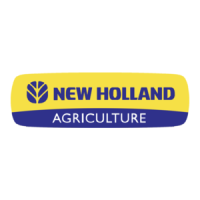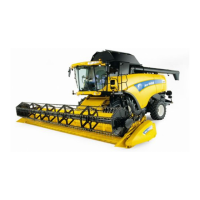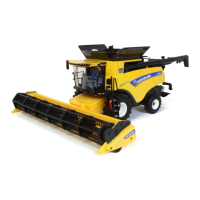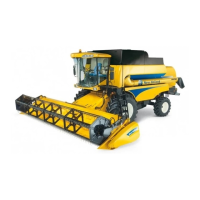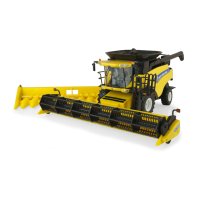Do you have a question about the New Holland CX760 and is the answer not in the manual?
Recommends using specific lubricants sold by dealers, based on engineering specifications.
Explains the placement and significance of safety decals on the machine for operator and bystander safety.
Describes various protective devices and safety features installed on the machine.
Provides step-by-step instructions and precautions for towing the combine, emphasizing avoiding hydrostatic damage.
Provides an overview of the cab layout and controls, including access and safety features.
Details the procedure for safely exiting the cab through the emergency exit.
Explains the operation and display fields of the InfoView monitor, controlled via cursor keys and keypad.
Explains the Automatic Crop Settings (ACS) system, its modes, and how to save user settings for different crops.
Explains how operators can configure machine settings and perform various calibration procedures.
Outlines the various calibration procedures necessary for correct operation and read-outs on the InfoView monitor.
Details the automatic process for calibrating the header, including necessary pre-checks and step-by-step instructions.
Explains how to calibrate the tyre radius for accurate ground speed readings, including specific distance measurements.
Guides the operator through the process of calibrating the multifunction handle for forward, reverse, and neutral positions.
Explains the procedure for calibrating the concave position to ensure accurate read-outs on the InfoView monitor.
Provides instructions for calibrating the upper sieve, including checking for cleanliness and proper opening.
Details the procedure for calibrating the lower sieve, similar to the upper sieve calibration.
Outlines the automatic calibration process for the self-levelling cleaning shoe, including engine speed and combine leveling.
Guides the operator on calibrating the maximum stubble height, which affects the area counter's operation.
Details the procedure for calibrating the ground speed hydrostatic system, emphasizing the multifunction handle and gear selection.
Lists the calibration procedures required for the SmartSteer system to function correctly.
Provides instructions for calibrating the HGS Turntable actuator, ensuring it's done when the SmartSteer system is installed or the actuator is new.
Explains the process for calibrating the HGS Turntable sensor, ensuring it correctly detects crop edges.
Details how to calibrate the rear axle steering cylinder sensor to its zero driving straight forward position.
Explains the procedure for calibrating the crop edge detection, which adjusts the SmartSteer sensor for crop edges.
Covers procedures related to the header, including header type, platform type, and usage settings.
Explains how the system searches for header block information based on recognition sensor data.
Allows setting crop type, flow sensor type, moisture sensor type, crop delay, data logger type, and DGPS unit type.
Guides on changing the crop selection, with notes on when not to change it.
Lists essential checks and procedures to perform before driving the combine, covering safety, tensions, pressures, and lubrication.
Provides a step-by-step guide for safely starting the engine, including pre-start checks and daily procedures.
Details the correct procedure for stopping the engine, including throttle control and ignition key removal.
Explains how to drive the combine, including gear selection, brake pedal coupling, and steering characteristics.
Describes how to select gears using the selector switch and the function of the parking brake during gear changes.
Provides an overview of the combine harvester's five basic functions: feeding, threshing, separation, cleaning, and grain storage/unloading.
Explains the five basic functions of the combine harvester: feeding, threshing, separation, cleaning, and grain storage/unloading.
Details how to adjust crop settings for optimal combine performance based on crop type and conditions.
Explains the procedure for performing a "kill-stall" to accurately check the combine's performance.
Covers procedures related to the header, including attaching and detaching it from the combine.
Details the steps for securely attaching the header to the combine, including drive coupling and electrical connections.
Explains the procedure for safely detaching the grain header from the combine.
Describes how to perform header settings and header calibrations, and how to use automatic header height control modes.
Explains the stubble height mode and how Autofloat sensors adjust the header to field contours.
Explains the automatic system that protects header skid shoes by reversing the combine.
Details the automatic reel to ground speed synchronization system and how to adjust the reel speed ratio.
Describes the system for reversing the header reel, auger, and straw elevator to clear blockages.
Provides instructions for removing and installing the straw elevator, noting its weight and tractor lift capacity requirements.
Covers components and adjustments related to the threshing system, including anti-dust plates and drum/concave settings.
Lists parameters for selecting drum speed and concave clearance and provides fundamental adjustment guidelines.
Offers guidance on adjusting drum speed and concave clearance for optimal threshing effect and minimizing grain damage.
Explains how to adjust drum speed electro-hydraulically from the operator's platform and important precautions.
Provides instructions on how to clear a drum blockage, including cleaning, lowering the concave, and using a socket wrench.
Details how to adjust concave clearance electrically and lists basic settings for different concave types.
Provides step-by-step instructions for removing and installing the drum concave, including checks for cleaning shoe level.
Emphasizes the importance of regular lubrication and maintenance for machine longevity and performance.
Details where grease fittings are located and the recommended intervals for greasing.
Covers engine oil level, oil and filter change intervals, specifications, and cooling system maintenance.
Explains fuel level checking, tank capacity, fuel specification, storage, and prefilter/water separator maintenance.
Details oil reservoir level checks, oil and filter changes, and specifications for hydraulic and hydrostatic systems.
Covers maintenance for brake fluid level, fluid change procedures, capacity, and specifications.
Explains how to check and adjust drive belts and chains for optimal operation, with specific diagrams for left-hand and right-hand sides.
Covers maintenance for foot brakes and parking brake, including cleaning and checking linings.
Emphasizes the importance of hydraulic hose safety, production dates, replacement intervals, and manual operation in case of electric failure.
Outlines the procedures for adjusting the steering axle, including position, axial position, height, track width, toe-in, and cylinder adjustments.
Outlines the service schedule for various intervals (pre-start, run-in, daily, 50, 100, 200, 300, 600 hours, and 2/4-6 year services).
Lists common concerns related to feeding, their possible causes, and corrections for irregular feeding.
Addresses issues like grain not properly threshed, material wrapping, drum blockage, and grain loss over straw walkers.
Details causes and corrections for grain loss over straw walkers, including crop condition and adjustments.
Explains common causes of poor grain cleaning, such as insufficient air blast or blocked sieves, and their corrections.
Identifies causes of machine blockage and provides corrective actions, including speed adjustments and belt checks.
Lists common engine-related concerns like starting issues, low power, overheating, and stalling, with their causes and solutions.
Addresses concerns related to straw chopper operation, such as vibration, poor chop quality, blockages, engagement issues, warm bearings, and flapping belts.
Provides instructions for manually releasing the hydraulic parking brake if electrical release fails.
Outlines the steps for preparing the combine for storage at the end of the season to ensure good condition for the next use.
Lists procedures to be followed at the beginning of each season to ensure the machine is in good condition and ready for use.
Checklist for customer maintenance after the first 50 hours.
Checklist for dealer maintenance after the first 50 hours.
Recommends using specific lubricants sold by dealers, based on engineering specifications.
Explains the placement and significance of safety decals on the machine for operator and bystander safety.
Describes various protective devices and safety features installed on the machine.
Provides step-by-step instructions and precautions for towing the combine, emphasizing avoiding hydrostatic damage.
Provides an overview of the cab layout and controls, including access and safety features.
Details the procedure for safely exiting the cab through the emergency exit.
Explains the operation and display fields of the InfoView monitor, controlled via cursor keys and keypad.
Explains the Automatic Crop Settings (ACS) system, its modes, and how to save user settings for different crops.
Explains how operators can configure machine settings and perform various calibration procedures.
Outlines the various calibration procedures necessary for correct operation and read-outs on the InfoView monitor.
Details the automatic process for calibrating the header, including necessary pre-checks and step-by-step instructions.
Explains how to calibrate the tyre radius for accurate ground speed readings, including specific distance measurements.
Guides the operator through the process of calibrating the multifunction handle for forward, reverse, and neutral positions.
Explains the procedure for calibrating the concave position to ensure accurate read-outs on the InfoView monitor.
Provides instructions for calibrating the upper sieve, including checking for cleanliness and proper opening.
Details the procedure for calibrating the lower sieve, similar to the upper sieve calibration.
Outlines the automatic calibration process for the self-levelling cleaning shoe, including engine speed and combine leveling.
Guides the operator on calibrating the maximum stubble height, which affects the area counter's operation.
Details the procedure for calibrating the ground speed hydrostatic system, emphasizing the multifunction handle and gear selection.
Lists the calibration procedures required for the SmartSteer system to function correctly.
Provides instructions for calibrating the HGS Turntable actuator, ensuring it's done when the SmartSteer system is installed or the actuator is new.
Explains the process for calibrating the HGS Turntable sensor, ensuring it correctly detects crop edges.
Details how to calibrate the rear axle steering cylinder sensor to its zero driving straight forward position.
Explains the procedure for calibrating the crop edge detection, which adjusts the SmartSteer sensor for crop edges.
Covers procedures related to the header, including header type, platform type, and usage settings.
Explains how the system searches for header block information based on recognition sensor data.
Allows setting crop type, flow sensor type, moisture sensor type, crop delay, data logger type, and DGPS unit type.
Guides on changing the crop selection, with notes on when not to change it.
Lists essential checks and procedures to perform before driving the combine, covering safety, tensions, pressures, and lubrication.
Provides a step-by-step guide for safely starting the engine, including pre-start checks and daily procedures.
Details the correct procedure for stopping the engine, including throttle control and ignition key removal.
Explains how to drive the combine, including gear selection, brake pedal coupling, and steering characteristics.
Describes how to select gears using the selector switch and the function of the parking brake during gear changes.
Provides an overview of the combine harvester's five basic functions: feeding, threshing, separation, cleaning, and grain storage/unloading.
Explains the five basic functions of the combine harvester: feeding, threshing, separation, cleaning, and grain storage/unloading.
Details how to adjust crop settings for optimal combine performance based on crop type and conditions.
Explains the procedure for performing a "kill-stall" to accurately check the combine's performance.
Covers procedures related to the header, including attaching and detaching it from the combine.
Details the steps for securely attaching the header to the combine, including drive coupling and electrical connections.
Explains the procedure for safely detaching the grain header from the combine.
Describes how to perform header settings and header calibrations, and how to use automatic header height control modes.
Explains the stubble height mode and how Autofloat sensors adjust the header to field contours.
Explains the automatic system that protects header skid shoes by reversing the combine.
Details the automatic reel to ground speed synchronization system and how to adjust the reel speed ratio.
Describes the system for reversing the header reel, auger, and straw elevator to clear blockages.
Provides instructions for removing and installing the straw elevator, noting its weight and tractor lift capacity requirements.
Covers components and adjustments related to the threshing system, including anti-dust plates and drum/concave settings.
Lists parameters for selecting drum speed and concave clearance and provides fundamental adjustment guidelines.
Offers guidance on adjusting drum speed and concave clearance for optimal threshing effect and minimizing grain damage.
Explains how to adjust drum speed electro-hydraulically from the operator's platform and important precautions.
Provides instructions on how to clear a drum blockage, including cleaning, lowering the concave, and using a socket wrench.
Details how to adjust concave clearance electrically and lists basic settings for different concave types.
Provides step-by-step instructions for removing and installing the drum concave, including checks for cleaning shoe level.
Emphasizes the importance of regular lubrication and maintenance for machine longevity and performance.
Details where grease fittings are located and the recommended intervals for greasing.
Covers engine oil level, oil and filter change intervals, specifications, and cooling system maintenance.
Explains fuel level checking, tank capacity, fuel specification, storage, and prefilter/water separator maintenance.
Details oil reservoir level checks, oil and filter changes, and specifications for hydraulic and hydrostatic systems.
Covers maintenance for brake fluid level, fluid change procedures, capacity, and specifications.
Explains how to check and adjust drive belts and chains for optimal operation, with specific diagrams for left-hand and right-hand sides.
Covers maintenance for foot brakes and parking brake, including cleaning and checking linings.
Emphasizes the importance of hydraulic hose safety, production dates, replacement intervals, and manual operation in case of electric failure.
Outlines the procedures for adjusting the steering axle, including position, axial position, height, track width, toe-in, and cylinder adjustments.
Outlines the service schedule for various intervals (pre-start, run-in, daily, 50, 100, 200, 300, 600 hours, and 2/4-6 year services).
Lists common concerns related to feeding, their possible causes, and corrections for irregular feeding.
Addresses issues like grain not properly threshed, material wrapping, drum blockage, and grain loss over straw walkers.
Details causes and corrections for grain loss over straw walkers, including crop condition and adjustments.
Explains common causes of poor grain cleaning, such as insufficient air blast or blocked sieves, and their corrections.
Identifies causes of machine blockage and provides corrective actions, including speed adjustments and belt checks.
Lists common engine-related concerns like starting issues, low power, overheating, and stalling, with their causes and solutions.
Addresses concerns related to straw chopper operation, such as vibration, poor chop quality, blockages, engagement issues, warm bearings, and flapping belts.
Provides instructions for manually releasing the hydraulic parking brake if electrical release fails.
Outlines the steps for preparing the combine for storage at the end of the season to ensure good condition for the next use.
Lists procedures to be followed at the beginning of each season to ensure the machine is in good condition and ready for use.
Checklist for customer maintenance after the first 50 hours.
Checklist for dealer maintenance after the first 50 hours.
| Brand | New Holland |
|---|---|
| Model | CX760 |
| Category | Farm Equipment |
| Language | English |
